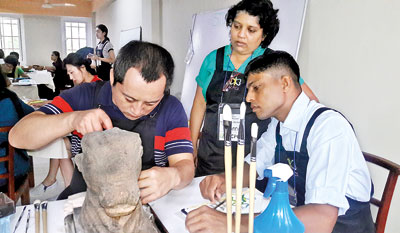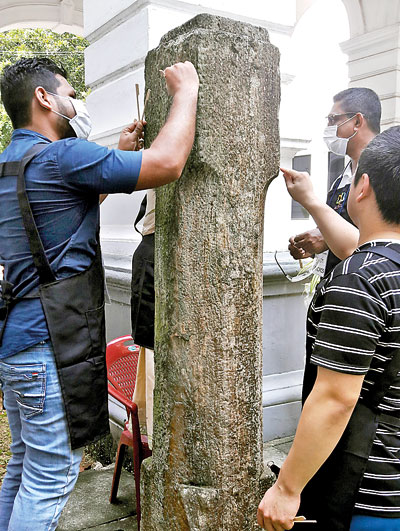Touching up our heritage with a little help from Korea

Fruitful collaboration: A Korean expert works on an artifact watched by local staff. (Pix courtesy: Department of National Museums)
Several white marble bodhisathwa statues, a grinding stone for herbal concoctions (behethoruwa), a figuring of the‘Holy Cow Nandi’ believed to be the mount of Lord Shiva and his gate keeper dating back to our ancient kingdoms, several bronze guardian figures retrieved from an ‘image house’ in Owagiriya, Ampara and fragments of a copper mixed lamp unearthed from Manabharana stupa in Siyambalanduwa were the specimens selected for the recently concluded ten-day metal and stone conservation project at the Colombo Museum.
The project was a collaborative venture between the National Research Institute of Cultural Heritage, Korea (NRICH) and the Ministry of Cultural Affairs (Ministry of Internal Affairs, Wayamba Development and Cultural Affairs).
The Department of National Museums and the Department of Archaeology were the joint beneficiaries of the project which proved to be a platform of mutual learning and knowledge sharing. The NRICH Korea is committed to research and conservation of cultural heritage, both locally and internationally. Under its Asia Cooperation Programme on Conservation Science (ACPCS), selected Asian countries are offered training in conservation science on diverse themes.
Artifacts are ‘speaking objects’ which hold testimony to the lives of our forefathers, says the Additional Secretary, Ministry of Internal Affairs, Wayamba Development and Cultural Affairs, Pradeepa Serasingha. “Technology is ever-evolving to conserve these ‘speaking objects’ and as custodians of this invaluable evidence, the NRICH-initiated project was a wonderful opportunity for us to bring home this knowledge.” The NRICH input was free and it was a productive opportunity for both the Department of National Museums and the Department of Archaeology staff to hone their skills and knowledge, she said.
“For NRICH’s ‘2016 Onsite Technical Training Programme’ (OTTP) we were selected as the beneficiary-nation and the invitation was extended to the Department of National Museums and the Department of Archaeology,” explains Development Assistant, Ministry of Internal Affairs, Wayamba Development and Cultural Affairs and the Coordinator of the project for the Ministry, S. Lanka Geeganage. The selected objects drawn from the Archaeology Department and the National Museum of Colombo were chosen after a ‘conditional assessment’.
The signature feature of the programme as Mr. Geeganage notes, is the fusion of modern technology with traditional know-how. “The NRICH strongly believes in drawing inspiration from authentic knowledge as well, hence this project was a mutually beneficial exercise.”

The long term objective of the programme is to extend the shared knowledge to other media as well, points out Director, Department of National Museums, Sanuja Kasthuriarachchi. “Pre-conservation which is the phase before an object starts deteriorating, is an on-going exercise at all our museums but this was the first time metal and stone objects were especially focused on,” explains Ms. Kasthuriarachchi who points out that the knowledge garnered will be extended to similar objects at the Museum.
The range of metal and stone objects the National Museum in Colombo and other regional museums coming under its purview claim is so vast, conservation is a huge challenge, she points out.
For Head of Conservation, Department of National Museums, Nilmini Neththasinghe, the whole exercise was invigorating. “I had the good fortune of undergoing training at the NRICH in Korea, yet I found this a novel experience. Not only did I acquire new knowledge but I also realized that the methodology of delivery was more advanced.” The field of conservation is ever evolving, says the Conservation Officer who credits her team as well as the Korean experts for being proactive in the exercise. “Just as much as our officers acquired finer tips in the preparation of chemical solutions, handling new instruments etc, the NRICH experts also took home with them locally-acquired knowledge.”
The National Museum has a mammoth collection of metal and stone objects including an impressive collection of coins. All of these objects are restored and given ‘touching-ups’ as and when required. The specimens selected for the ten-day project included both ‘indoor’ objects and ‘outdoor’ objects such as stone pillars (see pic below) found in the National Museum premises.


